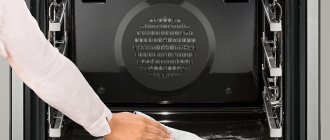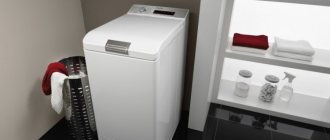Has your old Soviet refrigerator broken down and you need to buy a new one? It’s worth taking your choice more seriously, because it’s not a cheap purchase, but it should serve without fail day after day for decades. The most important question that arises when purchasing is which cooling system to choose so as not to make a mistake. Which is better - drip or dry freezing? What are the advantages and disadvantages of each of them? A detailed comparative description will answer this pressing question.
Refrigerator with drip system
Both types of units cool products due to the action of the refrigerant in the system. Only the type of redistribution and removal of moisture is different.
Principle of operation
In a refrigerator with a drip system, the evaporator is located behind the back wall and excess ice collects on it. During periods when the compressor is in a quiet state, the frost thaws and gradually flows down the wall into a special tray. Water evaporates naturally in the outer compartment.
Operating principle of a refrigerator with a drip system
It is worth paying attention to the fact that the ice particles in the condensate are small in size and do not settle on the side walls even with intensive operation of the compressor.
Advantages and disadvantages
This decision has positive and negative sides.
Advantages of the drip system:
- No accelerating fans and silent operation;
- Retaining up to 95% of natural moisture in products;
- Wide range of models to choose from;
- Spacious freezer storage compartments;
- A simple, reliable mechanism is not afraid of power surges;
- Low energy consumption and affordable price.
Disadvantages of the drip system:
- Ice formation on open foods in the freezer;
- Long period of temperature recovery after defrosting;
- Uneven distribution of products over the entire area;
- The temperature on the lower shelves is 5-7 °C lower than under the freezer;
- The need for periodic defrosting 1-2 times a year.
Drip refrigerators must be defrosted
Principle of operation
Take a look at this infographic. Here we tried to visualize everything we know about these defrosting systems.
Drip system
The first and more common is the drip system or, as it is also called, “crying”.
The principle of operation of this system is to locate a special evaporator behind the rear wall of the refrigeration chamber. This device distributes cooling along this wall, as a result of which condensation forms on its surface - droplets of water, which slowly flow into a special container.
It is because of this phenomenon that such refrigerators are called “crying.”
Note that in this case, the side panels and other surfaces of the chamber remain dry, and when the compressor is active, the condensate freezes, forming small pieces of ice.
No frost system - what is it?
The No Frost technology (from the English No frost - “no frost”) has a slightly different operating principle, which is as follows.
Cooling of the refrigerator and freezer compartments is also carried out using a compressor and evaporator, which is located in the rear compartment of the refrigerator.
In this case, the low temperature is distributed throughout the chambers using hidden fans that ensure constant air circulation.
In such refrigerators, condensation also releases and freezes on the back wall, but it is significantly less than in a drip system.
In simple words: in such a refrigerator a fan is constantly running, which evenly distributes the cold throughout the chamber.
This video clearly and clearly shows the process of operation of a refrigerator with the No frost system:
And here is also one of the reviews about this technology:
This is interesting: Rating of the best stainless steel electric kettles of 2022 (TOP 12)
Refrigerators with No Frost system
The relatively recent invention of a special moisture removal system has found its fans and is distinguished by some features.
Principle of operation
In refrigerators with an innovative No Frost cooling system, condensation also collects on the back wall. Thanks to a special ventilation system, cold air is evenly distributed in the cooling cabinet of the unit. This design solution prevents the formation of ice on the rear wall.
The principle of operation of a refrigerator with the No Frost system
The secret is simple - the air from the chambers, in the process of intensive circulation, enters the cooler, accumulates in the form of condensation and flows into the compartment.
The literal translation of the name of the No frost system from the original language means “without frost,” which accurately reflects the essence of the operation of such a refrigerator.
Advantages and disadvantages
The solution has a number of advantages over the drip cooling system:
- Uniform temperature distribution throughout all cabinet compartments;
- Less need for deep cleaning and complete shutdown;
- Really instant freezing of food in the freezer;
- Products cooled to −18 °C do not stick together and remain fresh longer in their original form;
- Quick restoration of operating temperature after shutdown;
- No condensation or frost on the back wall of the cooling cabinet.
In this refrigerator the temperature is distributed evenly
The disadvantages include a number of the following factors:
- A large ventilation unit requires space, which reduces the useful volume of storage rooms;
- The air redistribution system creates a lot of noise, which is not always convenient at night;
- Consumes more electricity than refrigerators with a drip defrosting system;
- When the complex electronics of the mechanism fail, it requires expensive repairs;
- A refrigerator with a No Frost system always costs an order of magnitude higher than a unit with a drip system.
Common misconceptions about the No Frost system
There are a large number of misconceptions among users regarding the design and operation of the system. Here are the most common ones.
MYTH No. 1. Refrigerants from the No Frost compressor system are extremely harmful to the environment and gradually release gas into the apartment space, thereby poisoning the residents.
Absolutely untrue! Dry freeze refrigerators use exactly the same gas as units with a drip cooling system. For example, refrigerant R600a.
MYTH No. 2. It dries out food and makes it unfit for food within a day after storage.
This assertion is partially justified. The intensive operation of the ventilation system, driving air through, evaporates natural moisture. But storing food in any refrigerator in open containers is not recommended. This creates an accumulation of unpleasant odors that are difficult to eliminate. When storing food in closed containers or under film, their freshness is maintained for a long time.
It is not recommended to store foodstuffs open.
Important! Many models have a special “Fresh Zone” compartment where ventilation flows do not enter. There, products are stored without changing their appearance and nutritional quality for a long time.
MYTH No. 3. There is absolutely no need to defrost due to the absence of frozen frost.
Fundamentally wrong! Purely for reasons of hygiene, a refrigerator with a dry freeze system must be cleaned at least once a year. In order for the cleaning to be more thorough, the unit must be disconnected from the network.
MYTH No. 4: A refrigerator with such a system has much less free space inside the cabinet.
This is true! Ventilation units take up useful space, and there will not be much space in the freezer compared to units with a drip defrosting system.
Advantages and disadvantages
Drip
Of course, one of the main advantages of the drip system is its affordable price. In addition, these refrigerators are distinguished by a large volume of refrigerating chambers and a wide range of products. In terms of operation, these devices are quite quiet and consume less electricity than their counterparts.
Older models of cooling devices required completely manual defrosting (turn off the equipment, wait for the pieces of ice to thaw, manually remove them all and clean the chamber). Drip defrosting significantly reduces the list of necessary actions. Everything is done very simply: the water is drained and the water vessel is installed in its original place.
Modern technology, consisting of many small mechanisms and equipped with automation, breaks down quite often. This can be caused by short circuits in the network, changes in atmospheric humidity and temperature. Units using a drip freezing mechanism operate reliably and without failure.
The disadvantages include unevenly distributed temperature throughout the chamber, periodic accumulation of ice on the back wall and a long restoration of the previous temperature after defrosting.
Defrosting such refrigerators usually takes much longer than their automated counterparts.
In addition, during defrosting it will be necessary to completely disconnect the device from the network. This means that food stored in the freezer will gradually melt. Some units can perform this process without completely stopping work.
"No Frost"
This system has a number of advantages: low maintenance, quick freezing option, no ice accumulation on the back wall. Refrigerators of the “No Frost” model ensure uniform temperature distribution throughout the entire chamber. For example, the temperature between the top and bottom shelves will be no more than 2 degrees Celsius. Whereas in models with a drip system, this temperature difference can reach five to six degrees. Maintaining a constant temperature allows food to be stored longer and stay fresh.
The “No Frost” system applies not only to refrigerators, but also to freezers. This is also an advantage over drip analogues.
Thanks to ventilation, the temperature in the refrigerator is restored faster after opening the door.
The design of the chambers implies good ventilation. Therefore, after closing the door, the previous temperature is restored much faster.
One of the disadvantages of such devices is their rather noisy operation. This is due to constantly running fans. However, it is worth noting that increasingly on the market you can find models that operate very quietly.
Due to their design, devices in the “No Frost” line lose competition to drip devices due to their small capacity.
Also, these models of cooling devices require a large amount of electricity. Although the difference from drip ones is not so huge, this can still be considered a disadvantage.
Such refrigerators cost a little more than their drip counterparts. Therefore, such devices cannot be considered a budget option.
Features of operation of refrigerators with no frost and drip system
Today there are many models of refrigerators on the market to suit every taste and need. The differences between modifications can be both very serious and insignificant.
Refrigerated cabinets may differ in internal filling:
- number of autonomous freezers;
- way of organizing space - shelves or containers;
- The material used to make the separation compartments is plastic or glass.
In addition, refrigerators are distinguished by:
- size and external color scheme;
- number of operating compressors;
- availability of additional useful options.
However, there are other factors to consider when choosing a freezing system.
Easy to care for
As mentioned above, refrigerators with a drip defrosting system need to be turned off periodically to defrost ice from the back wall. In addition, it is not recommended to place food in the freezer close to the back wall. After all, no one will like the prospect of peeling off the ice from a grocery bag in the future.
Periodic defrosting is mandatory for drip refrigerators
From the point of view of saving time and effort of the user, the No Frost system is more preferable. This is because there is no need to wait for it to thaw and remove ice from the freezer yourself.
Attention! Under no circumstances should you peel the ice from the walls of the case and rub the surface with an iron sponge. Abrasive products are completely avoided when cleaning your refrigerator.
Energy class
Due to the continuous operation of the fan unit, refrigerators with dry mode consume more electricity. Optionally, they are better equipped and each additional feature, for example, an audible door open indicator, also requires energy consumption.
Refrigerator energy consumption classes
Noise level
The same ventilation unit produces quite a lot of noise during operation. That is why dry freeze refrigerators deservedly enjoy the reputation of being quite noisy units.
The refrigerator produces especially high decibels when the fans accelerate intensively immediately after closing the door.
Volume inside the refrigerator
The simple design of the cooling system of drip-type refrigerators frees up a large amount of usable space in the storage compartment and makes them more spacious.
It is worth noting that the need to maintain some distance from the back walls of the freezer makes this “merit” quite controversial.
The drip type has more usable area
Quality of food preservation
Intense air circulation in No Frost refrigerators has a negative effect on food and dries out their surface, evaporating natural moisture. In fairness, it is worth noting that a good housewife will never throw unwrapped food into the refrigerator. When wrapped, they retain their original appearance longer and do not spread odors throughout the entire area of the cabinet.
Products in a refrigerator with a drip system weather less. But berries and fruits are stored much better in dry air. Intensive ultra-fast freezing No Frost keeps frozen food safe and sound longer.
Ultra-fast freezing No Frost keeps food intact longer
Price
There is no clear answer to the question of what is better, the know frost or the “crying” system. It all depends on the preferences of the consumer and his financial capabilities. Each type of cooling has its own distinct advantages and disadvantages.
Attention! In this case, a very important rule applies - the latest models of any type of refrigerator have practically no differences in noise level. Modern fan noise suppression technology has made No Frost systems virtually inaudible.
Choose depending on your preferences and financial capabilities
At the same time, the old manual defrosting system is practically not used in “drip” models in the middle and higher price segments. The frost deposit in them is so small that it should not be taken into account. It can be removed quite easily and quickly with mandatory regular cleaning of the cabinet.
Most of the market is occupied by refrigerators with a wet freezing type due to their low cost due to the simplicity of the design of the cooling elements.
As a result, we can say:
- Drip refrigerators definitely benefit in price and significantly save the buyer’s budget;
- Units with dry freezing type are represented by fewer models;
- No Frost refrigerators produce more noise and consume more energy;
- The complex No Frost system requires expensive repairs by a qualified specialist in the event of a breakdown.
Common Misconceptions
According to some people, in refrigerators with the “No Frost” system, food is dried out. To some extent, this is true, because fans are installed in the refrigerator compartment. However, compared to drip analogues, the drying speed of products is not so high. In addition, modern refrigerators are often equipped with plastic containers, which not only extend the shelf life of food, but also prevent odors from mixing with each other.
Sometimes people are mistaken that refrigerators with the “No Frost” system do not need to be defrosted. Despite good ventilation, small pieces of ice still accumulate on the back wall of the chamber. Therefore, once a year it is recommended to turn off the refrigeration unit and clean the interior.
Quite often you can come across a myth about the dangers of the “No Frost” system. This is pure fiction. The main components of refrigerators with this function are the same as those installed on analogues with a drip system.
For those who couldn't decide
Technologies do not stand still and relatively recently (about 15 years ago) Bosch developed and implemented the Low Frost system. It is radically different from No Frost in the structure of the coolers. In it, the freezing elements are located behind all the walls of the refrigerator. Frost from the evaporator circuits forms in a minimal amount. The absence of a fan unit makes such refrigerators silent, economical and with large internal space.
The latest Low Frost system
There is also another solution - a combined cooling system. Units with this design are an order of magnitude more expensive than mono-system ones, but will satisfy the most demanding buyer. The peculiarity of the solution is that the No Frost cooling system is used in the freezer compartments, and the drip cooling system is used in the refrigeration cabinet.
Is it worth buying?
Many consumers are puzzled over which is better, a no frost or drip system. To make the right choice, you need to examine all the characteristic features of the models.
It is also important to dispel misconceptions about modern technologies:
- There is an opinion that air circulation causes food to dry out. This is true if they are stored openly. But no one has done this for a long time. To prevent the occurrence of an unpleasant aroma in the chamber, it is recommended to keep the products in a bag, container or other packaging. This will also prevent them from drying out, thereby extending their shelf life.
- No Frost is a refrigerator that does not need to be defrosted. In reality this is not the case. To prevent bacterial growth and to maintain cleanliness, containers should be washed periodically. In order to perform quality cleaning, the equipment is disconnected from the network. As a result, the chambers will defrost. A slight condensation forms on the walls. It must be completely eliminated during the cleaning process.
- Fans take up a lot of space, which reduces the usable internal volume. This is partly true. But, if necessary, you can purchase equipment that has two or more cameras. The main thing is that there is enough space in the kitchen to install a large unit.
- Refrigerators use refrigerants that can cause significant harm to human health. This is a misconception, since the devices use the same freon as in drip models. Therefore, you should not believe that know frost poses a health hazard.
In fact, there are many such myths. This is due to the fact that people who are not technically savvy express their erroneous opinions and spread them among others. To avoid becoming a victim of such conversations, you should take the help of a specialist when choosing a refrigerator. Consultants will tell you in detail everything that interests the buyer. This applies not only to general information, but also to the technical characteristics of a particular model.
This is interesting: Rating of the best computer speakers of 2022 (TOP 12)
Recommendations when choosing a device
Before purchasing, you should pay attention to the following factors:
- Availability of containers with lids for a dry cooling system. As a last resort, you can buy a set of glass boxes with a plastic lid;
- The noise level of the device during operation. You can ask the seller to turn on the unit right in the store. If after 10-15 minutes of continuous operation the noise is still audible in a room with a lot of people, what will happen at home?
- Energy saving class. A very important parameter in the context of constantly rising energy prices. It is recommended to choose devices of class A, A+, A++ . In this case, overpaying for a more expensive unit with the same number of options will be justified;
- Only a famous brand. In the event of a breakdown, finding a similar replacement part will not be easy when purchasing a refrigerator from a nameless budget brand. It is worth asking about the warranty period and first studying the instructions by calling the nearest service center before payment.
Watch a video about the know frost and drip system
What's better
It is impossible to unequivocally answer the question whether No Frost or a drip refrigerator is better. When comparing costs, the advantage goes to the device that requires defrosting. However, this indicator is not important for all buyers. Drip refrigerators also benefit when considering the model range. It is easier to maintain refrigeration units equipped with a No Frost system, but due to the high noise level they can cause inconvenience to owners of studio apartments. In addition, if parts break, such refrigerators require expensive repairs.
When comparing the quality of food storage, the user's wishes should be taken into account. A drip refrigerator should be chosen by people who do not want to constantly pack food. For a person accustomed to cleanliness and order, a device with the No Frost system is suitable.
- How long before you can turn on the refrigerator after transportation?
- What is freon and how to refill a refrigerator at home
- Freezer Indesit SFR 167 NF with low noise level
- Refrigerator Atlant XM 6026-031 with two compressors
comparison table
In order to clearly analyze and compare the advantages and disadvantages of each automatic defrosting system, we have compiled a summary table.
| Drip (crying) system | |
| pros | Minuses |
|
|
| "No frost" system | |
| pros | Minuses |
|
|











